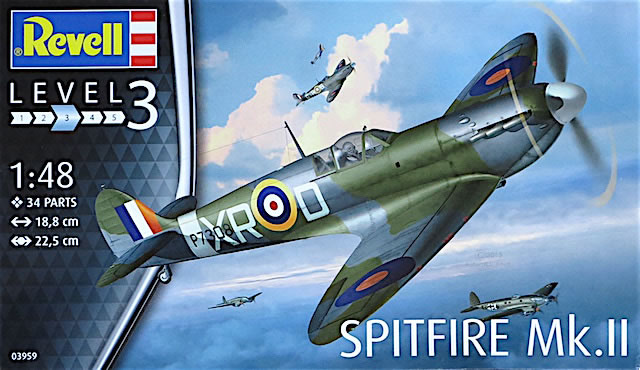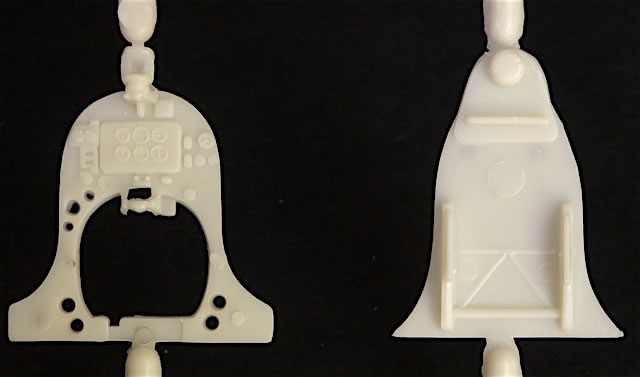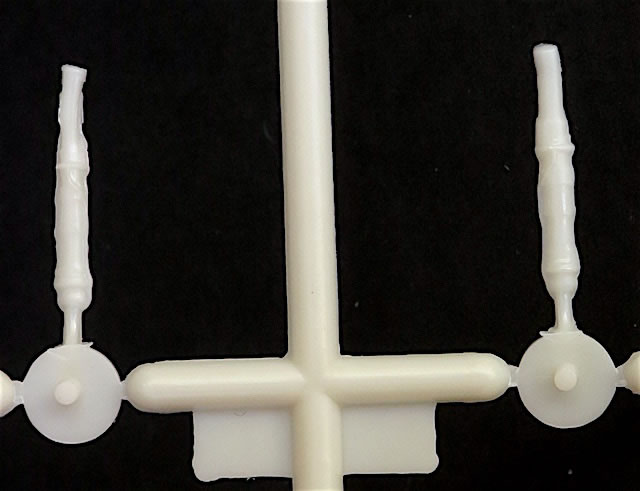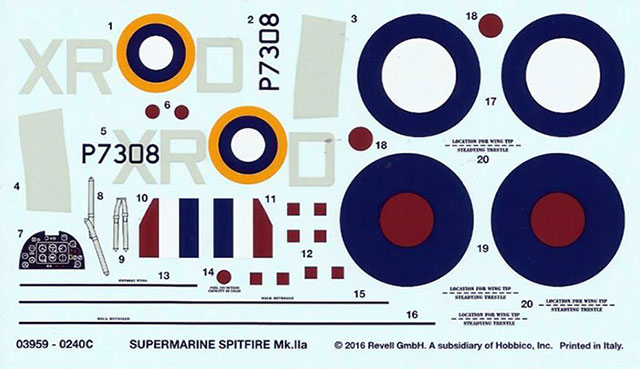Supermarine Spitfire Mk.II

Revell, 1/48 scale
| S u m m a r y : |
Catalogue Number: |
Revell Kit No.03959 – Spitfire Mk.II |
Scale: |
1/48 |
Contents and Media: |
29 white and 4 clear plastic parts; one decal sheet containing markings for one aircraft; 12 page full-colour A4 instruction booklet. |
Price: |
USD$13.99 plus shipping from Squadron
£9.99 plus shipping available online from Hannants' website
and specialist hobby retailers worldwide |
Review Type: |
First Look |
Advantages: |
Reasonable basic outline; interesting marking choice; high quality decals. |
Disadvantages: |
Soft or absent detail; no ‘gull wing’ effect; instructions could be more informative. |
Conclusion: |
Revell has put some effort into this reboxing of what is almost a vintage kit. The scheme chosen is for a historically significant but little known aircraft, and the decals appear to be good. The kit doesn’t compare to Tamiya’s or Airfix’s Mk.I kits, but it’s also half their price. This puts it firmly into beginner and/or pocket money territory, in which context I’m happy to recommend this kit. |
Reviewed by
Brad Fallen

Revell's 1/48 scale Spitfire Mk.II
is available online from Squadron.com for only $13.99!
According to my trusty SAM Datafile on Merlin-powered Spitfires, the Spitfire Mk.II was
"a Mk.I airframe with a more powerful Merlin engine (the Merlin XII)….Externally, both types were virtually identical…apart from the teardrop shaped blister which the Mk.II had on the starboard side of the nose immediately behind the spinner and which covered the Coffman starter."
The Mk.II entered RAF service in August 1940 and was pitched immediately into the Battle of Britain, where it performed ably alongside its Mk.I sibling. Almost all of the 900-plus Mk.IIs built were eight-gun Mk.IIas, although a handful finished as canon- and gun-armed Mk.IIbs.
Revell’s 1/48 Spitfire Mk.II kit was first released in 1979 and has since been re-boxed a number of times. Its most recent incarnation was earlier this year, when Revell released it with markings for P7308/XR-D operated by No.71 ‘Eagle Squadron’ RAF in August 1941.
Revell’s roughly A4-sized box carries attractive artwork of P7308 and other 71 Squadron Spitfires attacking a pair of He 111s. Unfortunately the box is end- rather than top opening, which makes it difficult to get sprues in and out of the box without damaging or losing parts.
In this regard, it’s fortunate the kit doesn’t have many parts – by my count only 33 (compared, for example, to 226 in Eduard’s recent 1/48 Mk.XVI bubbletop kit). The parts are held on three lightly populated sprues of white plastic, and one of clear. My experience with white plastic is that – as well as being difficult to photograph – it’s trickier than darker colours to model with because the details are harder to see.
In terms of accuracy, the major kit parts scale out fairly well against the SAM Datafile plans. The wings and fuselage are perhaps slightly undersized, but their shapes are generally OK. There is one major exception: absence of the characteristic Spitfire ‘gull wing’ effect where the wing and fuselage undersurfaces meet, which gives this section of the model an unusual appearance when the main parts are taped together.

All control surfaces are moulded in the neutral position. The distinguishing teardrop blister on the starboard side of the nose is present and looks reasonably accurate.
Panel lines are also mostly present and correct – a quick comparison with the Datafile plans suggests that only a few have been misplaced or omitted. The lines themselves are, of course, raised rather than engraved as is the case with modern kits, which means you’ll either need to protect the lines from damage during construction or remove and rescribe them. Either approach will have its challenges!
To me it’s in the details where this kit really shows its age. The cockpit is moderately well equipped, with instrument panel, control column, rudder pedals, seat and armour plate all provided. However the mouldings are clunky, and the sidewall detail moulded into the fuselage halves rudimentary. Decals are provided to represent instrument dials and seat harnesses – a welcome touch – but I think the cockpit will look its best with the canopy closed.
The undercarriage, exhausts and other external details fall into the same category. The radiator and oil cooler are moulded as part of the single piece lower wing, and while a separate blanking insert is supplied for the radiator, there isn’t one for the oil cooler which without some scratch-building treatment will be seen through from end to end.

The five-spoke wheels are correct for P7308, but the undercarriage covers and gear legs are very basic and would benefit from improvement or replacement. The gear legs also have very flimsy-looking fuselage attachment points, and I would doubt their longevity once attached to the model. The exhausts would also be best replaced, but the spinner and de Havilland three bladed propeller are fair representations of those fitted to P7308.
The instructions come in the form of a colour A4 booklet, with construction called out through 22 logically sequenced steps.
Marking Options
As I mentioned earlier, Revell supplies markings for only one aircraft – but it is a significant one. P7308 was flown by Eagle Squadron pilot William R. Dunn, the first US ace of World War II. According to several online sources, Dunn was at the controls of P7308 when he was badly wounded on 27 August 1941. The sources disagree as to whether this was as a result of combat, with the injured Dunn managing to land his damaged aircraft at RAF Hawkinge, or an accident at RAF North Weald. Either way both man and machine made full recoveries: Dunn transferred to the USAAF in 1943 and served another 30 years before retiring, while P7308 was repaired, converted to a Mk.Va and used by RAF operational and training units for at least another year.

Revell recommends P7308 be finished in the post-August 1941 RAF day fighter scheme of Ocean Grey and Dark Green over Medium Sea Grey. While this is plausible, the aircraft was manufactured in mid-1940 and so would have left the Castle Bromwich factory in Dark Earth and Dark Green over Sky. These are the colours that IWM Duxford used when they repainted Spitfire Mk.Ia AR213 as P7308 several years ago. I can’t tell from the original black-and-white photos of P7308 which of these colour schemes is right. Given August 1941 was when the schemes changed, if P7308 was grey and green it’s possible the upper surface grey was one of the locally mixed colours used before Ocean Grey became widely available.
None of this is mentioned in the instructions’ painting and marking guide, which contains good colour four-view drawings of P7308 but no information about the aircraft or its pilot. There is also a front-on drawing of the spinner and propeller that shows the location of the stencil decals on the blades. The drawings are a good match with period photos of the machine.
The decals look impressive on the sheet, with accurate colours, good density and crisp printing. To assist with registration the central red dots of the roundels have been printed separately, and will require careful alignment after the larger white and blue decals have dried.
Re-reading what I’ve written above, I sound quite harsh on this kit when I don’t mean to be. It is a product of its time, and a long way from the worst 1/48 Spitfire kit I have seen. With re-scribed panel lines and some updated details, a well-made model from this kit would definitely look the part, at least until it’s turned over and the lack of a gull wing becomes apparent. Revell’s made some effort with this latest re-boxing, too, providing good quality decals for a historically important Spitfire.
So is there still a place for this kit in the fairly crowded 1/48 early Spitfire market? It doesn’t compare to Tamiya’s or Airfix’s Mk.I kits, but it’s also half their price. This puts the kit firmly into beginner and/or pocket money territory, which I think is about right; in this context, I’m happy to recommend it.
References
-
Robert Humphreys, The Supermarine Spitfire – A Comprehensive Guide for the Modeller, Part 1: Merlin Powered (SAM Publications, 2000)
Revell model kits are available from all good toy and model retailers. For details visit www.revell.de/en, @RevellGermany or facebook.com/Revell

Review Text & Images Copyright © 2012 by Brad Fallen
Page Created 13 June, 2016
Last updated
13 June, 2016
Back to HyperScale Main Page
Back to Reviews Page |
